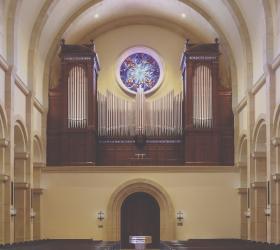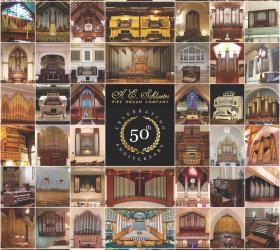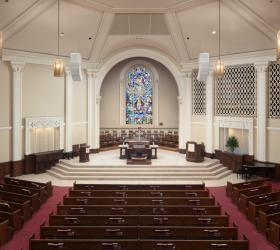
h2>M. L. Bigelow & Co., American Fork, Utah
St. Peter's Church in the Great Valley, Paoli, Pennsylvania
From the builder
Ever since pictures arrived, we were fascinated by the
pre-Revolutionary War church building of St. Peter's Parish. What could be more
fitting than a Colonial-style case on the gallery rail patterned after
Pennsylvania organbuilder David Tannenberg's casework of the late 1700s? The
tone would be full and satisfying in the intimate acoustics. The organ would
have mechanical key action and our unique Either/Or stop-action, where a stop
could be registered on either keyboard for maximum flexibility.
But nobody had ever built a two-manual instrument with
Either/Or registration on a gallery rail! What's more, the little balcony was
also home to a sizable choir in a parish with an ambitious music ministry.
Space was at a premium. One by one, the challenges were met, and the organ was
installed to a gracious welcome.
Colonial-styled casework is of solid hand-planed poplar,
painted white. Turned moldings and hand-carved and gilt pipe shades are in the
Tannenberg style. Façade pipes are of 75% tin with Roman arched mouths,
raised and soldered. The case is on the gallery rail with the key desk attached
to the back. A small flat-screen video monitor above the music rack provides a
bird's eye view of the nave and altar. Key action is mechanical. Keys are of
bone and ebony and rest on the pallets below by means of stickers (rigid
trackers). Stop action is mechanical with knobs directly above the
keyboards. Five stops are
available on either manual by means of Either/Or registration, (i.e., if a stop
is registered on one manual, it automatically retires when drawn on the other).
Swell shades are operated mechanically. All but the Open Diapason 8' and
Subbass 16' are enclosed. Subbass
pipes are on an electro-pneumatic offset chest located on the back wall of the
balcony. They are switched by optical contacts located on the pedal backfalls.
The blower and hinged bellows are housed in a box behind the organist.
We congratulate St. Peter's for their vision and ongoing
support throughout the entire project. It has been a most rewarding experience.
--Michael L. Bigelow
From the rector
Each Sunday, the musical offering of our choirs,
congregation and organist lifts us to the heavens, giving us a foretaste of the
eternal banquet that is prepared for us. Our beautiful new organ testifies that
we, the people of St. Peter's, are dedicated to offer our very best to God.
Additionally, the presence of this organ in our historic church, as we prepare
to build a new worship space, sends a powerful message that we are not
"abandoning the old for the new." Our beloved old church will always
be the vibrant spiritual center of our common life.
On behalf of the clergy and people of St. Peter's I wish to
thank God for the gift of inspiration to make this dream a reality. Thanks also
to Dr. Martha Johnson for her unfailing faith and vision; to Michael Bigelow
and his staff for their inspired craftsmanship; to Jonathan Ambrosino, our
consultant, for his sage wisdom and passion for excellence; to our principal
patron and other contributors for their generosity and love.
--The Rev. John G. Tampa
From the musician
For many years, St. Peter's has been dreaming of a pipe
organ to lead worship in our beautiful historic building. Although we were
discouraged by the limited available space in the gallery, one memorable
Evensong at which hymn-singing was led by a fine three-rank positiv organ made
us realize that it wouldn't take more than a few high-quality stops to fill our
intimate space.
The search for a builder was an education itself.
Imaginative proposals from several of this country's finest builders convinced
us it could be done. Michael Bigelow's proposal stood out for its inspired
design based on the cases of the 18th-century Pennsylvania builder David
Tannenberg, its sensitivity to the historical integrity of the 1744 church, and
his understanding of Episcopal worship.
Our wide range of musical needs was a challenge. Our five
choirs and many instrumentalists perform and lead music from Medieval times to
the present, from quiet offices to full choral Eucharists. Fortunately, St.
Peter's was planning a new worship space for the biggest services, so our new
instrument would have to lead only one room of singers.
Opus 30 has surpassed our dreams. Its physical loveliness
graces the church and its warm tone feels entirely at home with hymns, anthems
and voluntaries by Purcell, Wesley and Britten. Thanks be to God that out of
the vision of this congregation and the talents of these craftsmen we have an
organ that will take St. Peter's into the next centuries. Soli Deo Gloria!
--Martha Johnson
From the consultant
St. Peter's in the Great Valley is one of those jewel-like
situations that sparks the soul from first acquaintance. A winding drive
through dell and over stream leads one to an ancient graveyard, where stands a
pristine white church from 1744. Despite its small size (the seating capacity
is but 95), the church enjoys excellent, resonant acoustics--the sort of room
in which even the reluctant sing with vigor. Sheep tend the graveyard lawn,
baying kindly at parishioners through the open doors in summer.
Remarkably, the church never had a pipe organ. When I first
visited in the summer of 2000, an electronic instrument from the mid-1970s was
on its last legs. While planning for a second church has been underway for some
time (parish membership is approaching 1,000), all involved felt strongly that
the installation of a fine pipe organ would complete the 1744 edifice, marking
it forever as the parish's spiritual core.
From a consulting point of view, St. Peter's was the
simplest of projects. The rector grasped the vision from the outset and
invested complete confidence in the process. Martha Johnson approached her task
with craft, diplomacy and gusto. She is, to date, the only successful applicant
to the Pew Charitable Trusts for monies devoted to a pipe organ--so skillful
was her case statement of how the organ would serve as a tool for education.
There was no organ committee; Dr. Johnson essentially did all the work, using
her consultant as an occasional resource and her vestry as a sounding board.
Early on, the vision developed for a tracker organ that
would celebrate its modest size through maximum flexibility. The simplicity of
its action mirrors the church's own straightforward nature, stating clearly
that the organ intends to serve these people as long as the church itself might
stand. Its warm tone and delightful softer effects are expanded through
enclosure and either/or registration; short compass registers provide further
possibilities.
Visually, the organ has been a lifter of spirits. After
initial hesitation about the organ's elegant appearance, the congregation
reacted almost giddily to the arrival of the case, with its beautiful
proportions, finely-crafted moldings, carvings and gilding. When it came time
to apply gold leaf to the façade pipe mouths, dozens of parishioners
volunteered to help. In an organ where less had to be more, Michael Bigelow
knew intuitively when a little too much would end up being just right.
--Jonathan Ambrosino
Manual I
8'
style='mso-tab-count:1'> Open
Diapason (1-5 Stopp'd Diap,6-58 75% tin)
8'
style='mso-tab-count:1'> Stopp'd
Diapason (oak)
8'
style='mso-tab-count:1'> Viola
da gamba (1-12 Stopp'd Diap,13-58 75% tin)
4'
style='mso-tab-count:1'> Octave
(31%)
4'
style='mso-tab-count:1'> Flute
(chimney, 31%)
22/3' style='mso-tab-count:1'> Twelfth (31%)
2'
style='mso-tab-count:1'> Fifteenth
(31%)
13/5'
style='mso-tab-count:1'> Seventeenth (middle c,
31%)
Manual II
8'
style='mso-tab-count:1'> Viola
da gamba (alternates with I)
8'
style='mso-tab-count:1'> Stopp'd
Diapason (alternates with I)
4'
style='mso-tab-count:1'> Octave
(alternates with I)
4'
style='mso-tab-count:1'> Flute
(alternates with I)
2'
style='mso-tab-count:1'> Fifteenth
(alternates with I)
8'
style='mso-tab-count:1'> Hautboy
(TC, zinc and 50% tin)
PEDAL
16'
style='mso-tab-count:1'> Subbass
(poplar)
Total: 499 pipes
Couplers: I/Ped, II/Ped, II/I
Compass: 58/30
Tremulant/flexible wind off
Photo credit: William T. Van Pelt




